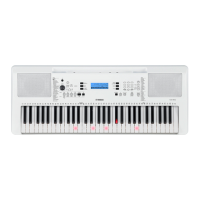Playing with Rhythm and Accompaniment (Styles)
EZ-300 Owner’s Manual
49
The Dictionary function is useful when you know the
name of a certain chord and want to quickly learn
how to play it.
1
Press and hold the [1 LISTENING
2 TIMING 3 WAITING] button for longer
than a second to call up “Dict.”
“Dict.” will appear in the display.
This operation will divide the entire keyboard into
the three ranges as illustrated below.
• The range to the right of “ ”:
Lets you specify the Chord Root, but produces
no sound.
• The range between “ ” and
“”:
Lets you specify the Chord Type, but produces
no sound.
• The range to the left of “ ”:
Lets you play and confirm the Chord specified
in the above two ranges.
2
As an example, learn how to play a GM7
(G major seventh) chord.
2-1.
Press the “G” key in the section to the right
of “ ” so that the “G” is shown as the
root note.
2-2.
Press the key labeled “M7” in the section
between “ ” and “ .”
The notes you should play for the specified
chord are lit. They are also shown in the
keyboard display.
To call up possible inversions of the chord, press
the [+/YES]/[-/NO] buttons.
3
Following the notation and keyboard dia-
gram in the display, try playing a chord
in the range to the left of “ .”
When you’ve played the chord properly, a bell
sound signals your success and the chord name
in the display flashes.
4
To exit from the Chord Dictionary mode,
press one of these buttons; [VOICE],
[SONG] or [STYLE].
Looking Up Chords Using the
Chord Dictionary
Hold for longer
than a second.
Chord Type range Root range Keyboard
playing range
• About major chords: Simple major chords are usually
indicated only by the root note. For example, “C” refers to
C major. However, when specifying major chords here,
make sure to select “M” (major) after pressing the root
note.
• These chords are not shown in the Chord Dictionary func-
tion: 6(9), M7(9), M7(
#
11) ,
b
5, M7
b
5, M7aug, m7(11),
mM7(9), mM7
b
5, 7
b
5, sus2
001
Dict.
Chord name (root and type)
Individual notes of chord
(keyboard)

